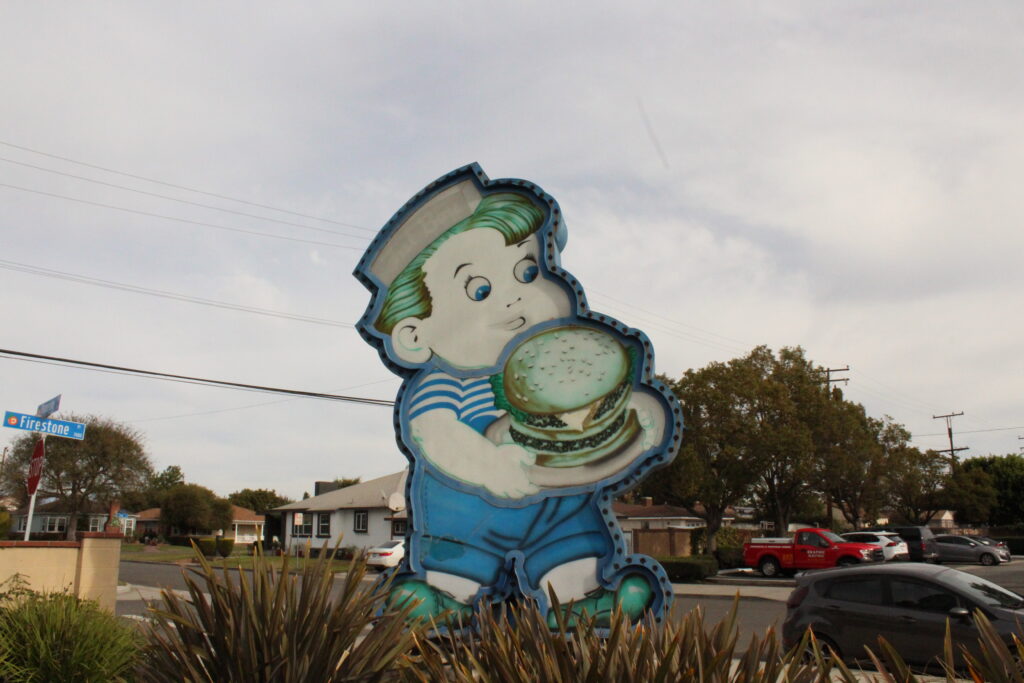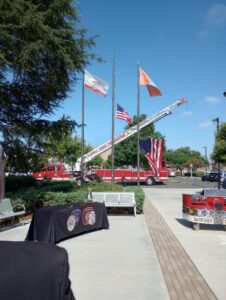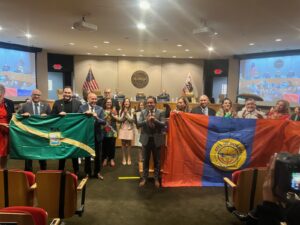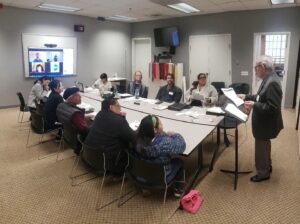
Lukas Luna
Far from a kitsch aesthetic, Bob’s Big Boy retro stylings speak to a historic significance that the chain helps to keep alive in Downey. But noble intentions only go so far, and they ultimately fail to save the restaurant from bland, forgettable food.
Keen eyed patrons who approach the Firestone Boulevard establishment’s entrance will notice a plaque beside the doorway. It mentions the building’s googie architecture and the historic value that it imparts. While it may seem like little more than a self-congratulatory note about the building’s architectural importance, further research unearths the unique place in Downey’s past Bob occupies.
Named for the now defunct Googie’s coffee shop located on Hollywood’s Sunset Strip before it was demolished in 1988, the design is known for its futurist influences, bright pops of color, and upward curves jutting upward. Should one ever wonder what the designers of mid-century Southern California envisioned their space age future would look like, the Googie style will provide the answer.
The building originally housed Johnie’s Broiler, which opened its doors in 1958. Weathering a name change and the rest of the century, the relic of 1950s cruising culture would eventually learn that nothing lasts forever and would close its doors on New Year’s Eve, 2001.
The story of Johnie’s nearly ended with it becoming a used car dealership and destined for footnote obscurity, but one horrible twist of fate would change all of that.
In 2007, a wrecking crew, working without permits, would partially demolish the historical landmark and leave it in tatters. They would leave only the main sign, the front facade, and the car canopies standing, in an illegal act that violated the LA counties preservation ordinance.
The sinister effort was halted thanks to the efforts of the citizens group Friends of Johnie’s, but those same citizens quickly concerned themselves with what was to be done to repurpose the site.
Enter: the Big Boy.
The city of Downey would eventually entrust franchise owner Jim Louder and his restaurant chain with bringing the landmark back from the brink and open a new addition to the Bob’s Big Boy family, which boasts 66 locations in the U.S. and—get this—hundreds of locations abroad.
Louder did exactly that. Downey’s Bob’s Big Boy opened its doors in 2008, a monument to the city’s commitment to ensure its malt shop past does not melt away.
The effort proved to alleviate fears the city would turn its back on its own history. Current member of the Downey Historical Society and former Friend Of Johnie’s George Redfox distinctly recalls the dread that the Big Boy would squash.
“I joined up with the friends because what happened didn’t seem right,” Redfox remembers. “That demolition seemed like the end … I thought they might let it go by the wayside.”
“There was such a huge outcry from the citizens,” he said. “I think that’s what prompted the city to get moving.”
Even without the extensive historical fact finding, there is a clear sense that the 1950s ambience of the restaurant is more than a shoddily assembled simulacrum. The walls are adorned with genuine memorabilia from the location’s heyday, Miles Davis trumpets “Blue and Green” over the jukebox, and the booths resting atop linoleum-style floors seem distinctly out of time.
The location’s success in retaining its history is unmistakable. Such a sentiment was echoed by the very same Friends Of Johnie’s group when they celebrated 10 years of the site’s rebirth in 2017.
“This is a really important place,” said Richard Schave, a member of that original citizen’s group, to The Downey Patriot. “This place brings together all the stuff about Southern California in the 60’s…this is a great success story for a lot of ideas and people and things that people care about and are threatened.”
Such a dedication to replicating that unique 50s aura has even fooled audiences on a national scale. The location was used to replicate an era appropriate restaurant for the popular “Mad Men” television show in its fourth season. It also served as environmental set dressing in the ABC Beach Boys miniseries “An American Family.”
This reverence extends to the menu, as well, in what might be the restaurant’s ultimate pitfall. Granted, diner style establishments like this one have been pulling from a similar catalog for years, and justifiably so. American standards are standards for a reason.
Add onto this a distinctly old school and midwestern tinge to many of the items available for consumption, and it becomes clear that its nostalgia is more than just window dressing. Bob’s puts their money where their mouth is.
But while that Big Boy Burger or Chili Spaghetti may look impressive on the menu, when it gets to your mouth it is a different story—a lunch at Bob’s Big Boy could hardly be distinguished from a lunch at any other similar establishment.
Consider the restaurant’s staple, the Big Boy Burger. Created by the chain’s founder shortly after doors opened, Bob Wian’s Big Boy Burger is widely considered to be the genesis of the double-decker hamburger
While that provides an interesting history, it is clear that the formula has since been improved upon by competitors. Only salvaged by the inclusion of an admittedly tasty signature red relish, the hamburger ultimately fails to be anything more than a piece of historical ephemera.
Of course, any restaurant would do well to stake its claim to fame on more than one dish. Among the many throwbacks to classic American cuisine on the menu, the chili spaghetti is sure to catch an eye.
Known for its ties to early 20th century immigration as well as the greater Cincinnati area, the dish can seem like an anachronism in a contemporary Southern Californian establishment.
But, as with the Big Boy, the item’s history doesn’t save it from the dull hand of mediocrity. The noodles themselves are perfectly serviceable, but the kick that is meant to be added by the chili is totally absent. Instead, one will be lucky to feel anything approaching a tingle as the historical article goes down.
As for the more humble items on the menu, in truth, they hold up far better than the alleged claims to fame. Club sandwiches, onion rings, and shakes (made with Thrifty’s ice cream) are the backbone of perhaps every greasy spoon in the country, and no one in their right mind would try to call it a signature.
But these basics ultimately prove to be Bob’s saving grace. Perhaps these dishes are too simple to fail? Perhaps the chefs at Bob’s have a mind for these standards? Either way, any trip to the restaurant is not complete without some of these classics on your plate. They may not serve the best variations on these American staples, but they are sure to leave you satisfied.
No one will ever confuse Bob’s Big Boy for Downey’s best. The dishes that are supposed to set the restaurant apart are disappointing, and the items of note could be found at any number of other, similar establishments. But any historically minded resident would be a fool to pass it by. Occupying a unique place in Downey’s history, it is a monument to our community’s resolve to ensure the past is not forgotten, and that is a noble cause no matter how you slice it.
Should you wish to make a meal of a one of a kind history, Bob’s Big Boy is located at 7447 Firestone Boulevard. Get the club, upgrade your side to half fries, half onion rings, wash it down with a vanilla shake, and listen to a song you might not have heard in a while.





